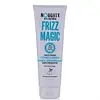What's inside
What's inside
 Key Ingredients
Key Ingredients

No key ingredients
 Benefits
Benefits

 Concerns
Concerns

 Ingredients Side-by-side
Ingredients Side-by-side

Water
Skin ConditioningMusa Sapientum Fruit Extract
Skin ConditioningCetearyl Alcohol
EmollientCetrimonium Chloride
AntimicrobialPhenoxyethanol
PreservativeParfum
MaskingHydroxyethylcellulose
Emulsion StabilisingLecithin
EmollientPanthenol
Skin ConditioningPropylene Glycol
HumectantSodium Hydroxide
BufferingAscorbic Acid
AntioxidantSr-Spider Polypeptide-1
Skin ProtectingLinalool
Perfuming1,2-Hexanediol
Skin ConditioningCaprylyl Glycol
EmollientCI 19140
Cosmetic ColorantCI 15985
Cosmetic ColorantWater
Skin ConditioningC13-15 Alkane
SolventCetearyl Alcohol
EmollientPropanediol
SolventCetrimonium Chloride
AntimicrobialBehentrimonium Chloride
PreservativePhenoxyethanol
PreservativeHydrolyzed Corn Protein
Skin ConditioningHydrolyzed Soy Protein
HumectantHydrolyzed Wheat Protein
Skin ConditioningCocodimonium Hydroxypropyl Hydrolyzed Wheat Protein
CleansingHydroxyethylcellulose
Emulsion StabilisingTrametes Versicolor Extract
Polyquaternium-37
Raphanus Sativus Seed Extract
Skin ConditioningCetearyl Nonanoate
EmollientButyrospermum Parkii Butter
Skin ConditioningPrunus Amygdalus Dulcis Seed Extract
Skin ConditioningCamellia Oleifera Seed Oil
Skin ConditioningHelianthus Annuus Seed Oil
EmollientTriticum Vulgare Bran Extract
Skin ConditioningSclerocarya Birrea Seed Oil
HumectantCitric Acid
BufferingHelianthus Annuus Seed Extract
Skin ConditioningLeuconostoc/Radish Root Ferment Filtrate
AntimicrobialLinoleic Acid
CleansingGlycerin
HumectantParfum
MaskingSodium Benzoate
MaskingButylene Glycol
HumectantEthylhexyl Isononanoate
EmollientTrisodium Ethylenediamine Disuccinate
Citrus Aurantium Dulcis Peel Oil
MaskingPotassium Sorbate
PreservativeRosmarinus Officinalis Leaf Extract
AntimicrobialLinalool
PerfumingLimonene
PerfumingHexyl Cinnamal
PerfumingWater, C13-15 Alkane, Cetearyl Alcohol, Propanediol, Cetrimonium Chloride, Behentrimonium Chloride, Phenoxyethanol, Hydrolyzed Corn Protein, Hydrolyzed Soy Protein, Hydrolyzed Wheat Protein, Cocodimonium Hydroxypropyl Hydrolyzed Wheat Protein, Hydroxyethylcellulose, Trametes Versicolor Extract, Polyquaternium-37, Raphanus Sativus Seed Extract, Cetearyl Nonanoate, Butyrospermum Parkii Butter, Prunus Amygdalus Dulcis Seed Extract, Camellia Oleifera Seed Oil, Helianthus Annuus Seed Oil, Triticum Vulgare Bran Extract, Sclerocarya Birrea Seed Oil, Citric Acid, Helianthus Annuus Seed Extract, Leuconostoc/Radish Root Ferment Filtrate, Linoleic Acid, Glycerin, Parfum, Sodium Benzoate, Butylene Glycol, Ethylhexyl Isononanoate, Trisodium Ethylenediamine Disuccinate, Citrus Aurantium Dulcis Peel Oil, Potassium Sorbate, Rosmarinus Officinalis Leaf Extract, Linalool, Limonene, Hexyl Cinnamal
Ingredients Explained
These ingredients are found in both products.
Ingredients higher up in an ingredient list are typically present in a larger amount.
Cetearyl alcohol is a mixture of two fatty alcohols: cetyl alcohol and stearyl alcohol. It is mainly used as an emulsifier. Emulsifiers help prevent the separation of oils and products. Due to its composition, it can also be used to thicken a product or help create foam.
Cetearyl alcohol is an emollient. Emollients help soothe and hydrate the skin by trapping moisture.
Studies show Cetearyl alcohol is non-toxic and non-irritating. The FDA allows products labeled "alcohol-free" to have fatty alcohols.
This ingredient is usually derived from plant oils such as palm, vegetable, or coconut oils. There is debate on whether this ingredient will cause acne.
Due to the fatty acid base, this ingredient may not be Malassezia folliculitis safe.
Learn more about Cetearyl AlcoholThis ingredient is a preservative, antimicrobial, and emulsifier. It is often used in cosmetics for its ability to cleanse, condition, and reduce static.
Cetrimonium chloride is a quaternary ammonium salt, meaning it has a water-soluble structure.
Hydroxyethylcellulose is used to improve the texture of products. It is created from a chemical reaction involving ethylene oxide and alkali-cellulose. Cellulose is a sugar found in plant cell walls and help give plants structure.
This ingredient helps stabilize products by preventing ingredients from separating. It can also help thicken the texture of a product.
This ingredient can also be found in pill medicines to help our bodies digest other ingredients.
Learn more about HydroxyethylcelluloseLinalool is a fragrance and helps add scent to products. It's derived from common plants such as cinnamon, mint, citrus, and lavender.
Like Limonene, this ingredient oxidizes when exposed to air. Oxidized linalool can cause allergies and skin sensitivity.
This ingredient has a scent that is floral, spicy tropical, and citrus-like.
Learn more about LinaloolParfum is a catch-all term for an ingredient or more that is used to give a scent to products.
Also called "fragrance", this ingredient can be a blend of hundreds of chemicals or plant oils. This means every product with "fragrance" or "parfum" in the ingredients list is a different mixture.
For instance, Habanolide is a proprietary trade name for a specific aroma chemical. When used as a fragrance ingredient in cosmetics, most aroma chemicals fall under the broad labeling category of “FRAGRANCE” or “PARFUM” according to EU and US regulations.
The term 'parfum' or 'fragrance' is not regulated in many countries. In many cases, it is up to the brand to define this term.
For instance, many brands choose to label themselves as "fragrance-free" because they are not using synthetic fragrances. However, their products may still contain ingredients such as essential oils that are considered a fragrance by INCI standards.
One example is Calendula flower extract. Calendula is an essential oil that still imparts a scent or 'fragrance'.
Depending on the blend, the ingredients in the mixture can cause allergies and sensitivities on the skin. Some ingredients that are known EU allergens include linalool and citronellol.
Parfum can also be used to mask or cover an unpleasant scent.
The bottom line is: not all fragrances/parfum/ingredients are created equally. If you are worried about fragrances, we recommend taking a closer look at an ingredient. And of course, we always recommend speaking with a professional.
Learn more about ParfumPhenoxyethanol is a preservative that has germicide, antimicrobial, and aromatic properties. Studies show that phenoxyethanol can prevent microbial growth. By itself, it has a scent that is similar to that of a rose.
It's often used in formulations along with Caprylyl Glycol to preserve the shelf life of products.
Water. It's the most common cosmetic ingredient of all. You'll usually see it at the top of ingredient lists, meaning that it makes up the largest part of the product.
So why is it so popular? Water most often acts as a solvent - this means that it helps dissolve other ingredients into the formulation.
You'll also recognize water as that liquid we all need to stay alive. If you see this, drink a glass of water. Stay hydrated!
Learn more about Water